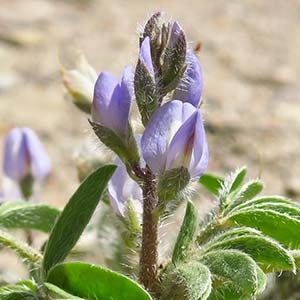|
intermountain lupine, low lupine, rusty lupine
|
green stipuled lupine, greenstipule lupine
|
| Herbs, annual, 0.5–2 dm, sparsely pubescent to pilose, hairs more than 1 mm. |
Herbs, perennial, 3–8 dm, green, spreading-hairy. |
short and tufted or erect, branched from base or near middle. |
erect, unbranched or branched. |
cauline, often crowded near base; stipules well developed; petiole 1–9 cm; leaflets 5–9, blades 10–40 × 5–10 mm, adaxial surface glabrous. |
cauline; stipules green, leaflike, lanceolate, 6–30 mm; petiole 3–6 cm; leaflets 6–9, blades 20–60 × 4–8 mm, adaxial surface pubescent. |
8–12-flowered, 2–11 cm, shorter than or slightly exceeding foliage; flowers spirally arranged. |
3–20 cm; flowers ± whorled. |
0–3.5 cm; bracts persistent, straight, 2–5 mm. |
1–11 cm; bracts deciduous, 4–10 mm. |
1–3.5 mm. |
2–7 mm. |
5–12 mm; calyx abaxial lobe entire, 5–6 mm, adaxial lobe cleft, 2.5–4 mm; corolla vivid blue, sometimes paler or white, sometimes bicolored, banner spot white or yellowish, keel glabrous. |
10–14 mm; calyx bulge or spur 0–1 mm, abaxial lobe entire or 3-toothed, 5–12 mm, adaxial lobe 2-toothed, 5–10 mm; corolla blue, banner patch white, banner glabrous abaxially, keel upcurved, usually glabrous, sparsely hairy near middle of adaxial margin. |
1.5 cm, constricted between seeds, thinly pilose to coarsely hirsute. |
2–4 cm, silky. |
persistent, disclike, sessile. |
deciduous, petiolate. |
2, wrinkled or ridged. |
2–6, beige, mottled brown, 4–5 mm. |
|
|
|
|
|
Flowering May–Sep. |
|
In mixed conifer forests, on granitic soils. |
|
1500–3000 m. (4900–9800 ft.) |
|
w North America; c North America
|
CA
|
Varieties 3 (3 in the flora). Lupinus pusillus is a highly variable species, with the varieties intergrading. (Discussion copyrighted by Flora of North America; reprinted with permission.) |
Lupinus fulcratus is found at higher elevations in the Sierra Nevada. It closely resembles L. andersonii except for the leaflike stipules. Lupinus ionewalkerae C. P. Smith, L. lingulae C. P. Smith, and L. cymbaegressus C. P. Smith may be hybrids with L. andersonii (P. A. Munz 1959). (Discussion copyrighted by Flora of North America; reprinted with permission.) |
1. Peduncles 0–1 cm; racemes shorter than foliage; flowers 6–8 mm. | var. intermontanus |
1. Peduncles usually 1–3.5 cm; racemes equal to or longer than foliage; flowers 7–12 mm. | → 2 |
2. Pedicels and calyx tubes strigose. | var. pusillus |
2. Pedicels and calyx tubes glabrous. | var. rubens |
|
|
| FNA vol. 11. |
FNA vol. 11. |
| Fabaceae > subfam. Faboideae > Lupinus |
Fabaceae > subfam. Faboideae > Lupinus |
L. adsurgens, L. affinis, L. albicaulis, L. albifrons, L. andersonii, L. angustiflorus, L. antoninus, L. apertus, L. arboreus, L. arbustus, L. arcticus, L. argenteus, L. arizonicus, L. benthamii, L. bicolor, L. brevicaulis, L. breweri, L. cervinus, L. chamissonis, L. citrinus, L. concinnus, L. constancei, L. covillei, L. croceus, L. dalesiae, L. diffusus, L. duranii, L. elatus, L. elmeri, L. excubitus, L. flavoculatus, L. formosus, L. fulcratus, L. gracilentus, L. grayi, L. guadalupensis, L. havardii, L. hirsutissimus, L. huachucanus, L. hyacinthinus, L. kingii, L. kuschei, L. lapidicola, L. latifolius, L. lepidus, L. leucophyllus, L. littoralis, L. longifolius, L. ludovicianus, L. luteolus, L. magnificus, L. malacophyllus, L. microcarpus, L. nanus, L. neomexicanus, L. nevadensis, L. nipomensis, L. nootkatensis, L. obtusilobus, L. odoratus, L. onustus, L. oreganus, L. pachylobus, L. padrecrowleyi, L. peirsonii, L. perennis, L. polyphyllus, L. pratensis, L. rivularis, L. sabineanus, L. sericatus, L. sericeus, L. shockleyi, L. sierrae-blancae, L. sparsiflorus, L. spectabilis, L. stiversii, L. subcarnosus, L. succulentus, L. sulphureus, L. texensis, L. tidestromii, L. tracyi, L. truncatus, L. uncialis, L. villosus, L. westianus |
L. adsurgens, L. affinis, L. albicaulis, L. albifrons, L. andersonii, L. angustiflorus, L. antoninus, L. apertus, L. arboreus, L. arbustus, L. arcticus, L. argenteus, L. arizonicus, L. benthamii, L. bicolor, L. brevicaulis, L. breweri, L. cervinus, L. chamissonis, L. citrinus, L. concinnus, L. constancei, L. covillei, L. croceus, L. dalesiae, L. diffusus, L. duranii, L. elatus, L. elmeri, L. excubitus, L. flavoculatus, L. formosus, L. gracilentus, L. grayi, L. guadalupensis, L. havardii, L. hirsutissimus, L. huachucanus, L. hyacinthinus, L. kingii, L. kuschei, L. lapidicola, L. latifolius, L. lepidus, L. leucophyllus, L. littoralis, L. longifolius, L. ludovicianus, L. luteolus, L. magnificus, L. malacophyllus, L. microcarpus, L. nanus, L. neomexicanus, L. nevadensis, L. nipomensis, L. nootkatensis, L. obtusilobus, L. odoratus, L. onustus, L. oreganus, L. pachylobus, L. padrecrowleyi, L. peirsonii, L. perennis, L. polyphyllus, L. pratensis, L. pusillus, L. rivularis, L. sabineanus, L. sericatus, L. sericeus, L. shockleyi, L. sierrae-blancae, L. sparsiflorus, L. spectabilis, L. stiversii, L. subcarnosus, L. succulentus, L. sulphureus, L. texensis, L. tidestromii, L. tracyi, L. truncatus, L. uncialis, L. villosus, L. westianus |
|
|
|
L. albicaulis var. fulcratus, L. andersonii var. fulcratus, L. beaneanus, L. finitus, L. fraxinetorum |
| Pursh: Fl. Amer. Sept. 2: 468. 1814[1813] |
Greene: Pittonia 3: 159. (1897) |
| |
